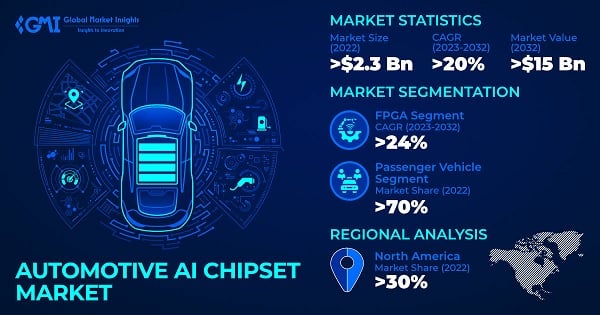Home > Automotive > Automotive Technology > Automotive Sensors > Automotive AI Chipset Market
Automotive AI Chipset Market Size
- Report ID: GMI6794
- Published Date: Sep 2023
- Report Format: PDF
Automotive AI Chipset Market Size
Automotive AI Chipset Market size was valued at over USD 2.3 billion in 2022 and is anticipated to grow at a CAGR of over 20% between 2023 & 2032. The pursuit of autonomous driving technology is a primary factor driving market growth. The rising preference for Electric Vehicles (EVs) is driving the need for efficient power management, and AI chipsets play a crucial role in optimizing battery performance. Automotive manufacturers are also increasingly integrating AI chipsets to enable vehicles to perceive and respond to their surroundings autonomously, enhancing safety & convenience. In-car infotainment systems and Advanced Driver Assistance Systems (ADAS), which are high in demand, also rely heavily on AI processing power. The quest for eco-friendly and connected vehicles will propel the adoption of AI chipsets over the forecast period.
Automotive AI chipsets are specialized integrated circuits designed to perform advanced data processing tasks within vehicles. These chipsets incorporate artificial intelligence and machine learning capabilities to analyze data from various vehicle sensors, cameras & radars.
| Report Attribute | Details |
|---|---|
| Base Year: | 2022 |
| Automotive AI Chipset Market Size in 2022: | USD 2.3 Billion |
| Forecast Period: | 2023 to 2032 |
| Forecast Period 2023 to 2032 CAGR: | 20% |
| 2032 Value Projection: | USD 15 Billion |
| Historical Data for: | 2018 to 2022 |
| No. of Pages: | 250 |
| Tables, Charts & Figures: | 263 |
| Segments covered: | Product, Application, Processing Type, Vehicle Type, and Region |
| Growth Drivers: |
|
| Pitfalls & Challenges: |
|
As AI chipsets gather and process vast amounts of data from vehicles, concerns over data privacy & security arise. Mishandling or breach of this data can lead to privacy infringements and raise legal & ethical questions for automotive companies. Also, the research, development, and manufacturing of cutting-edge AI chipsets require substantial investments. This can strain the budgets of automotive manufacturers, particularly smaller companies, potentially limiting their ability to adopt these technologies.

